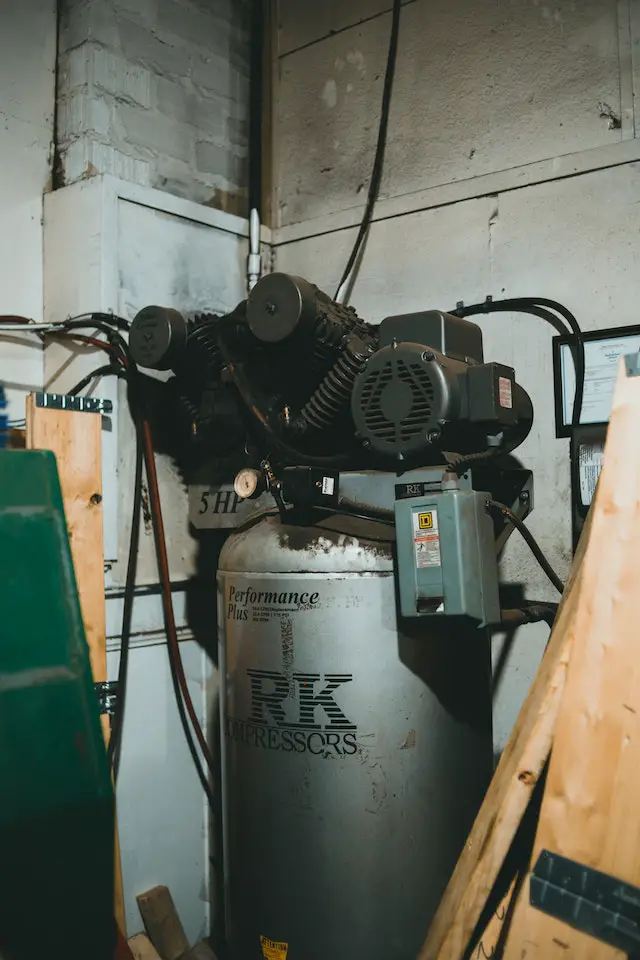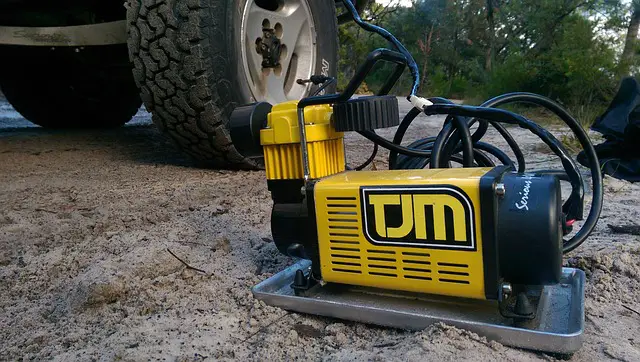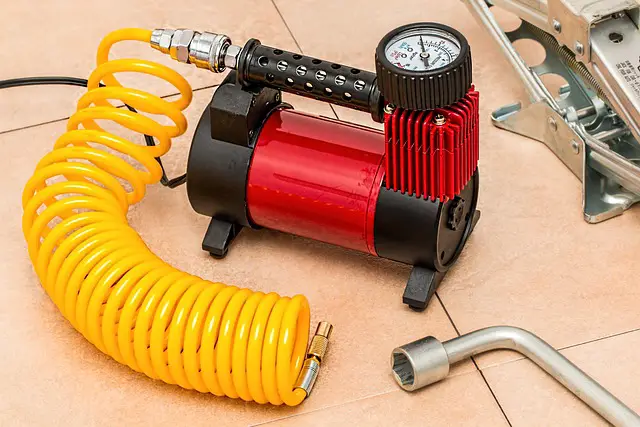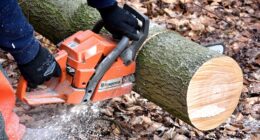Rotary compressors offer high efficiency, quiet operation, and compact size, making them suitable for a wide range of applications such as air conditioning systems or refrigerators. However, they can be more expensive than reciprocating compressors and may not be as reliable in extreme conditions. Reciprocating compressors are economical upfront costs-wise but can require more maintenance over time due to wear on its moving parts. They also tend to generate more noise during operation compared to rotary compressors.
What is a rotary compressor?
(Photo by Jonathan Cooper)

A rotary compressor is a type of compressor that uses rotating parts to compress gas or air. The most common types of rotary compressors are screw, vane, and scroll compressors. These machines feature a rotor that rotates within a cylinder, creating pockets that trap air or gas and then gradually reduce the volume by compression.
Screw compressors use two interlocking screws to create compressed air or gas. As the screws turn, they pull in air from one end and push it out through the other end at higher pressure.
Vane compressors use sliding vanes inside a cylindrical housing to generate compressed air. The vanes move in circular motion, trapping and releasing air as they rotate around the central axis.
Scroll compressors utilize two spiral-shaped scrolls positioned within each other with an offset angle between them. When one scroll moves across another scroll of opposite orientation, it creates small pockets where the size decreases towards their center as both scrolls rotate together.
Rotary compressors tend to be quieter than reciprocating ones due to their continuous operation without pulsation noises while being more suitable for high flow applications where large volumes of pressurized contents are required on demand considering its base-load energy consumption advantage over reciprocating counterparts
What is a reciprocating compressor?
(Image by adewhite from Pixabay )

A reciprocating compressor is a type of compressor that uses pistons to compress gas or air. This type of compressor works by drawing in air through an intake valve and then compressing it using a piston that moves up and down inside the cylinder. The compressed air is then pushed out through a discharge valve.
Reciprocating compressors are used in many different applications, from powering pneumatic tools to refrigeration systems. They come in both single-stage and multi-stage versions, with each stage adding additional compression to the air.
One major advantage of reciprocating compressors is their ability to produce high-pressure output. They can achieve pressures up to 7,000 psi, making them ideal for use in heavy-duty industrial applications.
However, there are also some disadvantages associated with this type of compressor. One such disadvantage is their relatively low efficiency compared to other types of compressors like rotary ones due to more mechanical losses from friction between moving parts.
Despite their drawbacks, reciprocating compressors remain an important part of many industries where high-pressure output is required.
How do rotary compressors work?
Rotary compressors work on the principle of positive displacement. They use a set of rotating vanes or screws to compress air or gas, which is then discharged at high pressure. The compression process in rotary compressors occurs within a sealed chamber made up of the compressor housing and the rotor assembly.
As the rotors rotate, they trap air or gas in between them and carry it towards the discharge port. As this happens, air gets compressed until it reaches its maximum pressure.
One significant advantage of rotary compressors is their continuous operation with no vibration or pulsation since there are no valves that open and close like reciprocating compressors. Also, they have a smaller size footprint than reciprocating ones (making them ideal for small spaces).
Rotary compressors can be further classified into two main types: helical screw and vane type. Helical screw compressors use two intermeshing screws that rotate to create pockets where air gets trapped and compressed as it moves along those pockets.
In contrast, vane-type rotary compressor uses sliding vanes mounted inside a circular rotor that rotates within an eccentric casing to cause compression by reducing volume as well as increasing pressure.
These designs make rotary systems more efficient than their counterparts because they have fewer moving parts resulting in less wear-and-tear over time leading to longer life cycles for your equipment at lower operating costs overall!
How do reciprocating compressors work?
Reciprocating compressors are a type of positive displacement compressors that work by using a piston to compress the gas. The piston moves back and forth in a cylinder, drawing gas into the cylinder on its intake stroke and then compressing it on its compression stroke.
The intake valve opens when the pressure inside the cylinder drops below atmospheric pressure, allowing gas to flow into the cylinder until it reaches the bottom dead center of the piston. As soon as this happens, both valves close and compression begins.
During compression, the piston moves upwards towards top dead center while reducing volume thus increasing pressure. Once it reaches top dead center, an exhaust valve opens to release compressed air or gas.
This process repeats itself over and over again until enough compressed air or gas is produced for whatever application is needed. Reciprocating compressors can produce high pressures with relatively low power inputs making them ideal for small-scale applications such as powering pneumatic tools or filling tires.
Reciprocating compressors require regular maintenance because they have many moving parts that need lubrication and replacement from time to time. They also generate vibrations during operation which can cause noise pollution if not properly installed or maintained.
What are the advantages and disadvantages of rotary compressors?
Rotary compressors are known for their high efficiency and low maintenance requirements. One of the main advantages of rotary compressors is that they have a continuous flow of compressed air. This means that there is no pulsation or vibration, which reduces noise levels and prevents the compressor from overheating.
Another advantage of rotary compressors is their compact size, which allows them to be easily installed in small spaces. They also have fewer moving parts than reciprocating compressors, which makes them more reliable over time.
However, one disadvantage of rotary compressors is that they can be expensive to purchase upfront. Additionally, they may require specialized maintenance by technicians who are familiar with their unique design and operation.
Another potential disadvantage is that some types of rotary compressors (such as screw compressors) may not be suitable for applications where oil-free compressed air is required. In these cases, additional filtration systems may need to be added to ensure compliance with industry standards.
If you need a compressor for an application where space-saving and high-efficiency features are crucial factors then you should definitely consider using a rotary compressor!
What are the advantages and disadvantages of reciprocating compressors?
Reciprocating compressors are a type of compressor that use reciprocating motion to compress gas. They’re commonly used in smaller, portable applications such as air conditioners and refrigerators due to their compact size.
One advantage of reciprocating compressors is their ability to handle varying loads. These compressors can be adjusted to handle different levels of compression depending on the load required, making them suitable for a wide range of applications.
However, one disadvantage is that they tend to have higher operating costs than rotary compressors due to their higher maintenance requirements. Reciprocating compressors also tend to produce more noise and vibration during operation compared to rotary types.
Another advantage is that reciprocating compressors are generally cheaper than rotary types, making them an economical choice for small-scale operations. In addition, these compressors typically offer better efficiency at lower speeds which can help conserve energy when running continuously.
On the other hand, one major disadvantage of reciprocating compressors is their limited lifespan and durability compared with rotary types. Additionally, these machines require frequent oil changes which can add up over time in terms of cost and hassle.
While there are certainly benefits and downsides associated with using reciprocating compressor technology – it all comes down to application-specific needs when deciding which type will suit best!
Which type of compressor is best for a fridge?
When it comes to choosing the right compressor for a fridge, there are several factors to consider. The size and capacity of the fridge should be taken into account, as well as energy efficiency and noise levels.
For smaller fridges, a rotary compressor may be the best choice due to its compact size and quiet operation. Rotary compressors work by using two rotating blades that compress refrigerant gas.
Reciprocating compressors, on the other hand, are better suited for larger fridges due to their higher cooling capacity. They use a piston-like motion to compress refrigerant gas.
Energy efficiency is also an important consideration when choosing a compressor for your fridge. Both rotary and reciprocating compressors can be designed with high-efficiency motors and components, but rotary compressors tend to have slightly higher energy efficiency ratings.
Noise levels should also be considered when selecting a compressor for your fridge. While both types of compressors can operate quietly with proper insulation and design features, rotary compressors generally produce less noise than reciprocating models.
Ultimately, the best type of compressor for your fridge will depend on your specific needs and preferences. It’s important to do research and consult with experts before making any final decisions.
Featured Image By – Steve Buissinne from Pixabay








